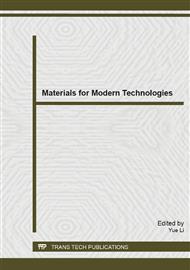[1]
N.M. Mahmoodi, B. Hayati, M. Arami, H. Bahrami, Preparation, characterization and dye adsorption properties of biocompatible composite (alginate/titania nanoparticle), Desalination 275 (2011) 93–101.
DOI: 10.1016/j.desal.2011.02.034
Google Scholar
[2]
S.S. Moghaddam, M.R.A. Moghaddam, M. Arami, Coagulation/flocculation process for dye removal using sludge from water treatment plant: Optimization through response surface methodlogy, J. Hazard. Mater. 175 (2010) 651-657.
DOI: 10.1016/j.jhazmat.2009.10.058
Google Scholar
[3]
S. Anandan, G-J Lee, P-K Chen, C. Fan, J.J. Wu, Removal of orange II dye in water by visible light assisted photocatalytic ozonation using Bi2O3 and Au/Bi2O3 nanorods, Ind. Eng. Chem. Res. 49 (2010) 9729–9737.
DOI: 10.1021/ie101361c
Google Scholar
[4]
Reza, A. Samanch, M. Ali, Application of polyaniline for removal of Acid Green 25 from aqueous solutions, J. Scientific Industrial Res. 70 (2011) 804–809.
Google Scholar
[5]
B. Hayati, N.M. Mahmodi, M. Arami, F. Mazaheri, Dye removal from colored textile waste water by poly(propylene imine) dendrimer: Operational parameters and isotherm studies, Clean - Soil Air Water. 39 (2011) 673–679.
DOI: 10.1002/clen.201000182
Google Scholar
[6]
Z.H. Wang, B. Xiang, Z. Zhai, Y.J. Li, Biosorption of acid dyes using modified chitosan: Effect of dye structure, hydrogen bonding and pH, Adv. Mater. Res. 236 – 238 (2011) 464.
DOI: 10.4028/www.scientific.net/amr.236-238.464
Google Scholar
[7]
R. Cheng, B. Xiang, Y. Li, Application of nickel (II) complex of dithiocarbamate-modified starch for anionic dyes removal from aqueous solutions, J. Appl. Polym. Sci. 123 (2012) 2439–2444.
DOI: 10.1002/app.34836
Google Scholar
[8]
M.P. E-Gonzalez, V. H-Montoya, Use of wide-pore carbons to examine intermolecular interactions during the adsorption of anthraquinone dyes from aqueous solution, Ads. Sci. Technol. 27 (2009) 447–460.
DOI: 10.1260/0263-6174.27.5.447
Google Scholar
[9]
N. Hoda, E. Bayram, E. Ayranci, Kinetic and equilibrium studies on the removal of acid dyes from aqueous solutions by adsorption into activated carbon cloth, J. Hazard. Mater. B 137 (2006) 344–351.
DOI: 10.1016/j.jhazmat.2006.02.009
Google Scholar
[10]
P. Kaushik, A. Malik, Process optimization for efficient dye removal by Aspergillus lentukus FJ 172995, J. Hazard. Mater. 185 (2011) 837–843.
DOI: 10.1016/j.jhazmat.2010.09.096
Google Scholar
[11]
V.K. Gupta, R. Jain, S. varshney, V.K. Saini, Removal of Reactofix Navy Blue 2 GFN from aqueous solutions using adsorption techniques, J. Colloid. Interf. Sci. 307 (2007) 326-332.
DOI: 10.1016/j.jcis.2006.12.003
Google Scholar
[12]
S. Mandal, S. Mayadevi, Defluoridation of water using as-synthesized Zn/Al/Cl anionic clay adsorbent: Equilibrium and regeneration studies, J. Hazard. Mater. 167 (2009) 873-878.
DOI: 10.1016/j.jhazmat.2009.01.069
Google Scholar
[13]
F. Bruna, R. Celis, I. Pavlovic, C. Barriga, J. Cornejo, M.A. Ulibarri, Layered double hydroxides as adsorbents and carriers of the herbicide (4-chloro-2-methylphenoxy) acetic acid (MCPA): Systems Mg-Al, Mg-Fe and Mg-Al-Fe, J. Hazard. Mater. 168 (2009).
DOI: 10.1016/j.jhazmat.2009.03.038
Google Scholar
[14]
S. Mandal, S. Mayadevi, Cellulose supported layered double hydroxides for the adsorption of fluoride from aqueous solution, Chemosphere 72 (2008) 995-998.
DOI: 10.1016/j.chemosphere.2008.03.053
Google Scholar
[15]
Martinse, A. Skijak-Braek, O. Smidsrod, Alginate as immobilization material: I. Correlation between chemical and physical properties of alginate gel beads, Biotechnol. Bioeng. 33 (1989) 79 – 89.
DOI: 10.1002/bit.260330111
Google Scholar
[16]
S. Mandal, V.S. Patil, S. Mayadevi, Alginate and hydrotalcite-like anionic clay composite systems: Synthesis, characterization and application studies, Micropor. Mesopor. Mater. 158 (2012) 241-246.
DOI: 10.1016/j.micromeso.2012.03.046
Google Scholar
[17]
I. Langmuir, The adsorption of gases in plane surface of glass, mica and platinum, J. Am. Chem. Soc. 40 (1916) 1361-1368.
Google Scholar
[18]
H.M.F. Freundlich, Over the adsorption in solution, J. Phys. Chem. 57 (1906) 385-470.
Google Scholar
[19]
S. Lagergren, About the theory of so-called adsorption of soluble substance, Handlingar 24 (1898) 1-39.
Google Scholar
[20]
L. Zhao, T. Xu, X. Lei, S. Xu, F. Zhang, Scalable preparation of alginate template layered double hydroxide mesoporous composites with enhanced surface areas and surface acidities, J. Nanosci. Nanotechnol. 11 (2011) 3291–3294.
DOI: 10.1166/jnn.2011.3739
Google Scholar
[21]
Treybal, R.E., Mass Transfer Operations, 3rd Edition, McGraw-Hill Book Company, Singapore, 1981, p.590.
Google Scholar


